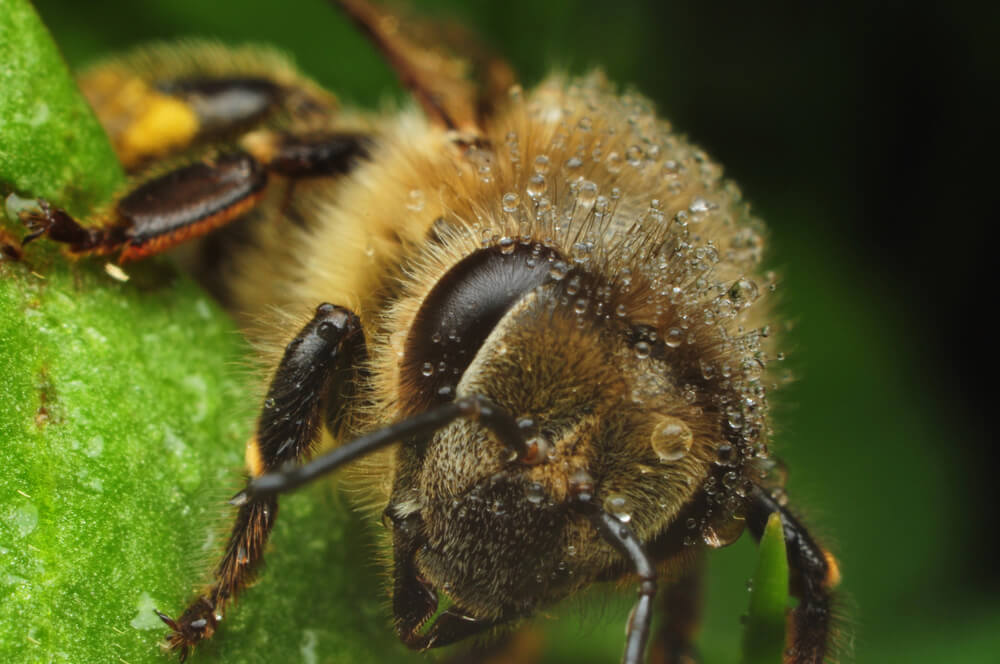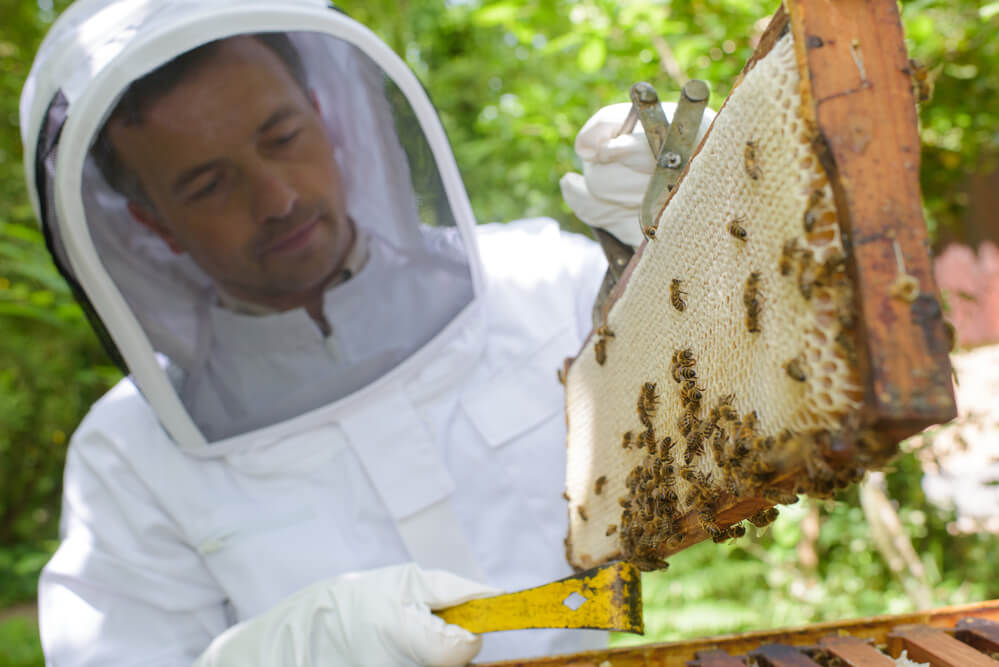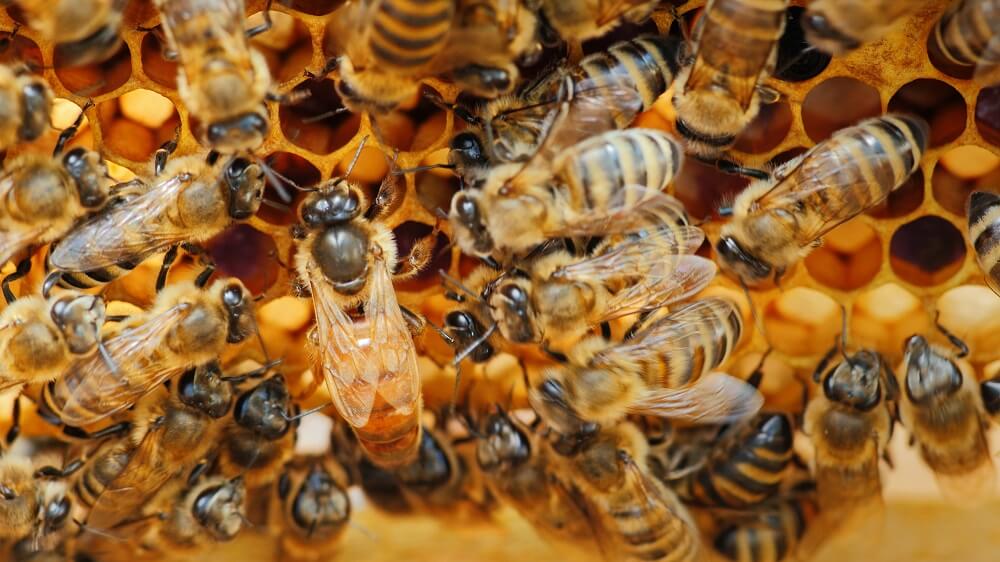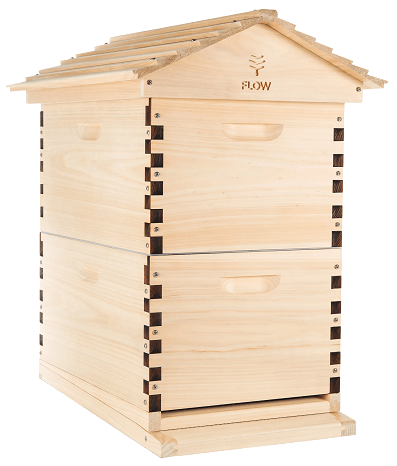This is an in-depth flow hive review. In this article, we’ll cover:
Ready?
Let’s begin.
Flow Hive Pros:
- You’ll save time and effort harvesting honey. The traditional way of harvesting honey is one of the hardest parts of beekeeping. It’s labor-intensive and can take several days, depending on how many hives you have. This is where the flow hive comes in. The flow method makes things fast, easy, and much cleaner. You just turn the key, and the honey pours out.
- Honey harvesting is less invasive for the bees. You don’t have to open the hive to collect the honey, so you’re not disturbing the colony. This makes for happier bees.
- The honey doesn’t require filtering. Honey from the flow hive contains very little wax, pollen, or bee parts. It’s pure honey that’s ready to be enjoyed.
- The flow frames are transparent. This helps you see how fast your bees are refilling the frames. It also allows you to gauge nectar flow.
Flow Hive Cons:
- The flow hive may not be ideal for colder climates. If you live in a climate with harsh winters, you may only be able to harvest honey once per year. And sometimes, you may not be able to harvest honey at all since your main priority will be helping your bees survive the winter. In this case, the flow hive might not be worth the investment.
- The flow hive is expensive. Depending on which flow hive you get, you’ll spend between $500 – $1,000. Spending this much money on a hive isn’t always practical for beginners. This is especially true if you’re unsure whether you’ll stick with beekeeping.
- The flow frames are plastic. Bees prefer to build their own combs. With that said, the bees will be more likely to use the plastic frames if you brush beeswax on them.
- You can’t harvest wax from the beehive while using the flow method. This isn’t a dealbreaker for some, but it’s worth mentioning.
Bottom Line:
If you’ve ever harvested honey the traditional way, then you’ll appreciate the flow hive method. You simply turn the key and let the honey flow into your container. This saves you several days worth of work. It’s also a less invasive way of harvesting honey because you don’t have to open the hive to collect it. This makes for happier bees. If you’re serious about beekeeping and want to simplify the honey harvesting process, then the flow hive is worth it.
The One Thing You Should Know Before Buying a Flow Hive

Let me be clear:
The main benefit of the flow hive is that you’ll save time and labor when harvesting honey.
But keep in mind:
You’ll still have to inspect your hives, monitor for diseases, deal with pests, make splits, re-queen when necessary, add supers, lift heavy boxes, etc.
And this is where beginners run into trouble.
They buy a flow hive assuming they can just “set it and forget it” then collect honey a few months later. This isn’t the case.
Why do I point this out?
Because this is one of the biggest criticisms of the flow hive. People say it promotes “lazy beekeeping.”
But that’s not true.
And to be frank, it isn’t fair to the flow hive. Certain people will be lazy no matter what type of hive they buy.
The bottom line is this:
If someone is lazy, they’ll be lazy.
But, finding a more efficient way of harvesting honey doesn’t make someone lazy. In fact, in the marketing videos for the flow hive, they remind you that you’ll still have to inspect and maintain your hive.
That’s why I can’t stress this enough:
Beekeeping is a lot of fun. But it also takes work.
If you ask any beekeeper you know, they’ll give you a million reasons why they love keeping bees. They find bees fascinating, love helping the environment, and enjoy the honey. It’s fun and rewarding.
But it also takes time, patience, and commitment.
And there’s a lot to learn. That’s why there are entire courses and books on beekeeping.
So my suggestion?
If you’re new to beekeeping, you should learn as much as you can about the hobby before investing your time and money into it.
What’s the worst that can happen?
You read a book or take a course and decide beekeeping isn’t for you. Or maybe you’re just not ready yet.
That’s a good thing.
You’re not only saving yourself time, but you’re saving yourself tons of money on beekeeping equipment.
Take me, for example.
I waited a year before becoming a beekeeper. During that time, I read beekeeping books and articles and watched beekeepers on YouTube.
And you know what?
I was a much better beginner beekeeper because of it. I learned so much that I would’ve missed if I had blindly jumped into the hobby.
Don’t know where to start?
I recommend beginning by reading this beekeeping book.
Now let’s move on to the million-dollar question…
Related: What Does a Queen Bee Look Like?
Which Flow Hive Should I Get?
We recommend the flow hive hybrid because it gives you the biggest bang for your buck. It’s the most affordable option, and it allows you to use flow frames or let the bees build their own comb. This is where the name “hybrid” comes in.
If you use this coupon, you’ll get $50 off your purchase.
With that in mind, there are four types of flow hives:
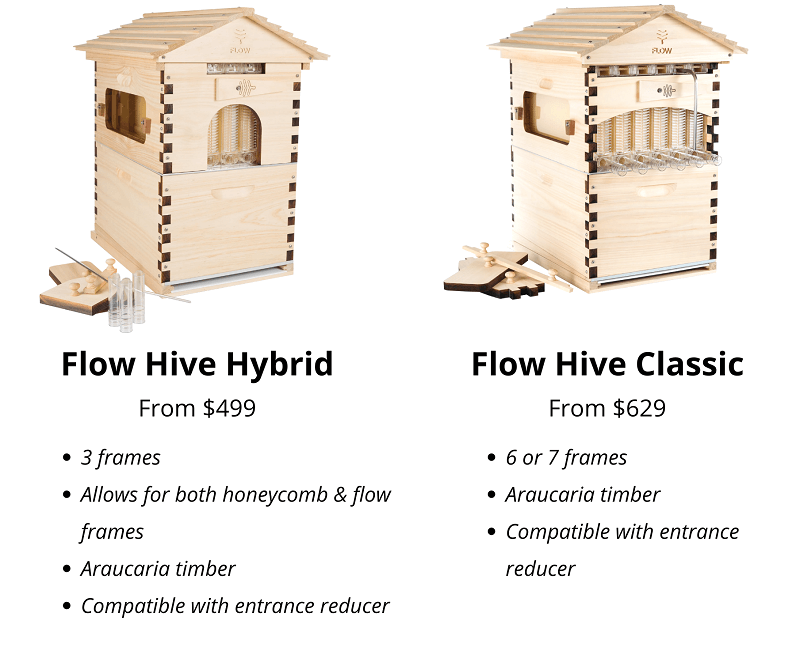
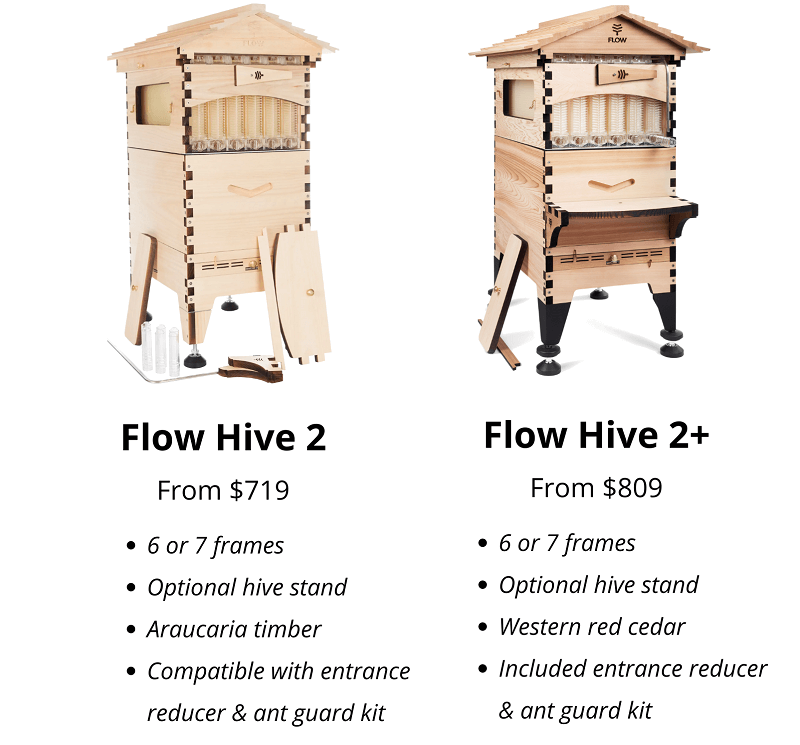
Let’s talk specifically about each one:
Flow hive 2+

This model is the most expensive flow hive. It ranges from $800-$969 depending upon which features you choose. You can pick between six or seven frames and decide if you want to add an adjustable hive stand or not.
So what’s the difference between the flow hive 2+ and the other hives?
The main differences are:
- It’s made of oil-stained premium wood
- It comes with an entrance reducer
- It comes with an ant guard leg kit
According to the company, the flow high 2+ is made of Western Red Cedar which is sustainably sourced and more durable than other types of wood.
The flow hive 2+ also comes with an entrance reducer. This can help protect your bees against predators and robbing from other hives. Plus, it can reduce drafts in cool climates and conceal the hive entrance for short periods if you have to move your hive.
Finally, it comes with ant guards on each leg stand that helps protect against pesky ants.
Flow hive 2
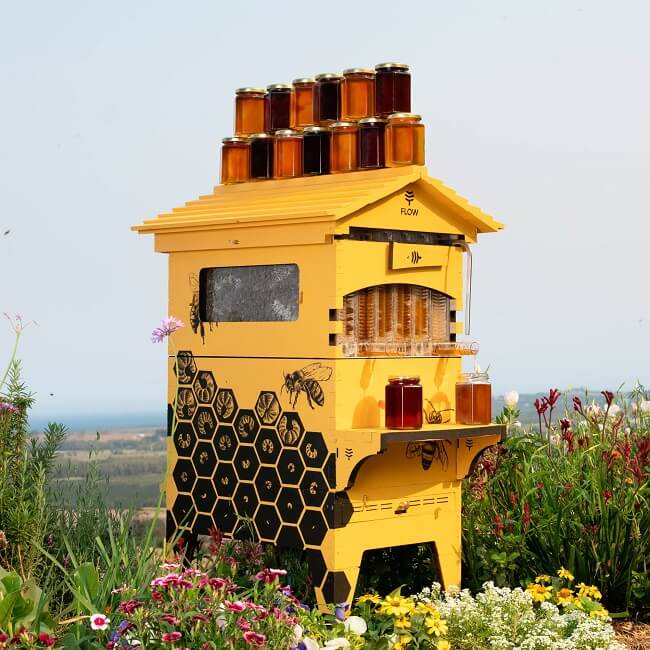
This is the best-selling flow hive. The price ranges from $719-$869. You can choose whether you want six or seven frames and if you want to add an adjustable hive stand or not.
It has similar features as the flow hive 2+, except the type of wood is different, and it’s painted instead of oil-stained.
That said, the wood is still a durable material and will last you a long time if you take care of it.
The other difference is the flow hive 2 doesn’t automatically come with an entrance reducer or ant guards. But the good news is that you can purchase both of those and add them on later if needed.
Flow hive classic
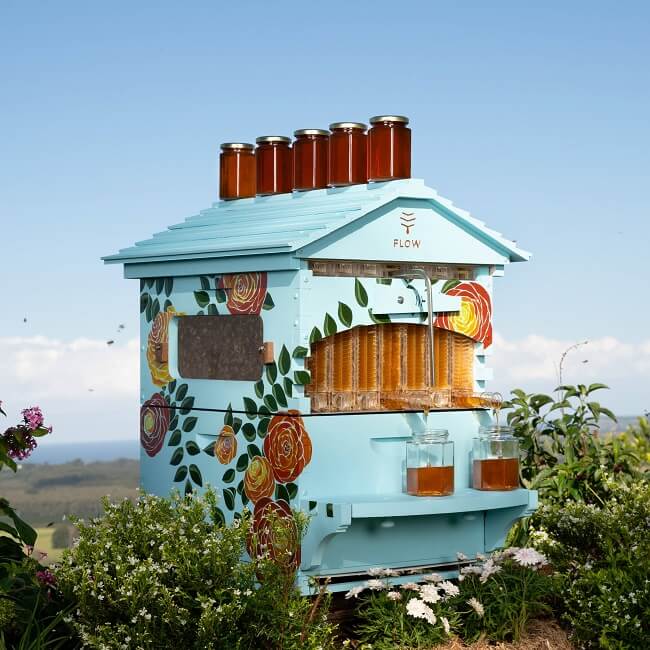
You guessed it.
The flow hive classic is their original design. You can pick between six or seven frames, and the price ranges from $629-$699.
The main difference between the flow hive classic and the other two hives we’ve mentioned is that it doesn’t come with a hive stand or ant guards.
This is no big deal.
You could make or buy your own hive stand and use your own ant guards. This will save you a couple of hundred dollars.
It also gives you the option to add an entrance reducer.
Flow hive hybrid
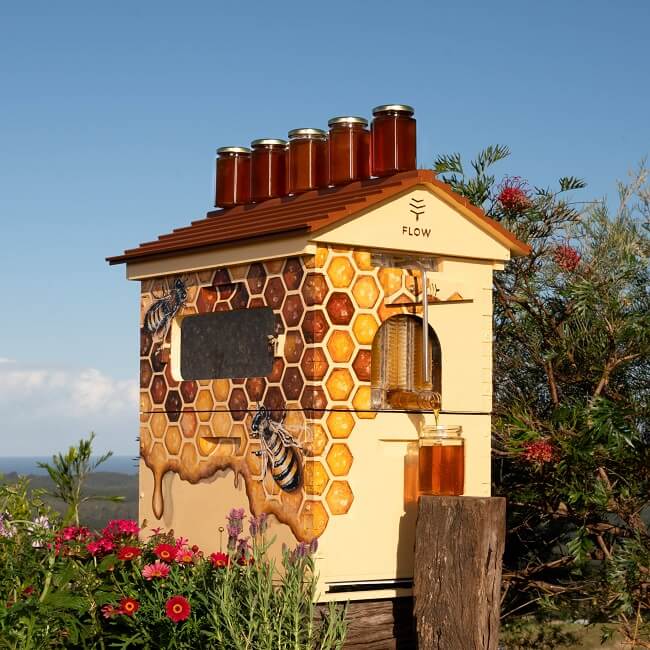
This is the hive that I recommend to beginners. By beginners, I mean new or experienced beekeepers who haven’t tried a flow hive.
Why do I recommend this one?
Simple.
It allows you to try a flow hive at a more affordable price to decide if you like it. If you decide it’s not for you, then you’ve saved yourself a couple of hundred bucks by choosing this option.
The flow hive hybrid uses three frames and costs $499. It’s called a hybrid because it allows you to harvest honey the traditional way or the flow hive way.
The traditional way of harvesting honey involves letting the bees build their own comb. This gives you honey and beeswax.
The flow hive way allows you to harvest honey from a tap. It uses a plastic foundation, so you don’t have to filter your honey because there is no beeswax in it. It gives you only pure, filtered honey.
The flow hive hybrid allows you to do both. To me, this is the best of both worlds.
If you plan on buying the flow hive, make sure to use this coupon so you can get $50 off.
Flow Hive Review FAQs
- Which flow hive is best?
- What are the pros and cons of a flow hive?
- How long do flow hives last?
- How do you maintain a flow hive?
- How do you harvest honey from a flow hive?
- How often can you harvest honey from a flow hive?
- What do beekeepers think of flow hives?
- How do you put bees in a flow hive?
- Do flow hives harm bees?
- How long does it take for a new hive to produce honey?
- Can you get honeycomb from a flow hive?
- How many bees fit in a flow hive?
- Where should a flow hive be placed?
- Can you stack flow hives?
- How do you prevent robbing from other colonies in a flow hive?
- What’s the history of the flow hive?
Which flow hive is best?
We recommend the flow hive hybrid because it’s the most affordable ($499) and allows you to harvest honey easily.
You get all the perks you need and can skip the extra unnecessary stuff that costs more.
For example, you can buy the flow hive 2+, which is the most expensive hive. It comes with a different type of wood, a hive stand, ant guards, and the ability to hold more frames.
These are nice perks, but they’re unnecessary for beginners.
My advice is to save yourself money initially and try the flow hive out to decide if you really like it.
What’s the worst that can happen?
You buy the flow hive and like it. This means you can upgrade to a more expensive flow hive later if you want.
Or, you don’t like the flow hive and don’t want to use it anymore. This means you’ve saved yourself a couple of hundred bucks by buying the most affordable option to begin with.
Also, use this $50 off coupon to get a discount.
—> Go back to the flow hive review FAQs
What are the pros and cons of a flow hive?
Let’s dive into a full flow hive review.
Flow Hive Review: The Pros
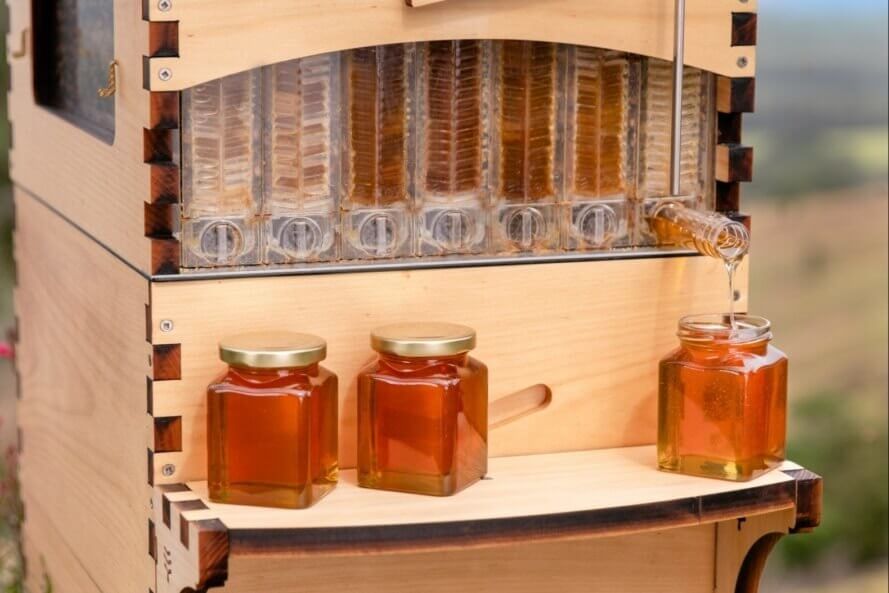
Let’s talk specifically about the pros and cons of the flow hive so you can make a smart purchase.
Pro 1: Honey harvesting is easier
Make no mistake.
Honey harvesting is often a beekeepers least favorite part of the backyard beekeeping process.
For starters, you have to pull the honey super off the hive then carry it to wherever you’re extracting. Next, you have to uncap the honeycomb and spin the frames in a honey extractor. This is where you collect your honey.
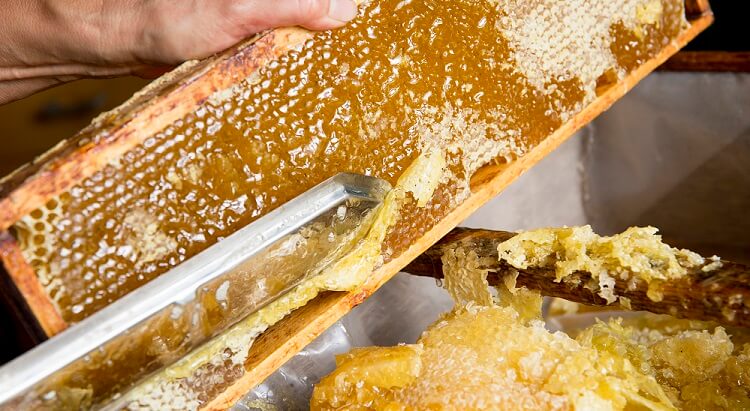
Finally, you have to put the frames back in the box, carry the box back to the hive, and clean your honey extractor.
Depending on how much honey you have, this can take several days.
You can also extract honey without a honey extractor, which is a good idea for new beekeepers or people with only a few hives. But, this process takes longer and can make a mess.
This benefit alone is what makes flow hives popular amongst beekeepers.
Pro 2: The honey harvesting is less invasive for your bees
The flow hive features a window on the side that lets you see the frames as they’re being capped.
Once the honey is ready to be harvested, you simply turn the key and let the honey flow from the hive into a container.
This means there’s no need to open the hive at all for the harvest.
Other methods of honey harvesting not only involve opening the hive but physically removing the bees from the frames. Beekeepers use brushes and smoke to deter the bees.
It’s not a fun process. But, it’s often needed if you’re ready to harvest honey.
And of course, there’s often the risk of crushing some bees in the process. The flow hive avoids that risk.
Pro 3: The honey doesn’t require filtering
The flow frames allow the honey to pour out of them without causing injury to any bees. The honey that comes from the hive contains very little wax, pollen, or bee parts.
There is minimal (if any) filtering needed.
Pro 4: The flow frames are transparent
This allows you to watch how quickly your bees are filling and refilling the frames. It also allows you to know how much honey they have and helps you gauge the nectar flow in your area.
Flow Hive Review: The Cons
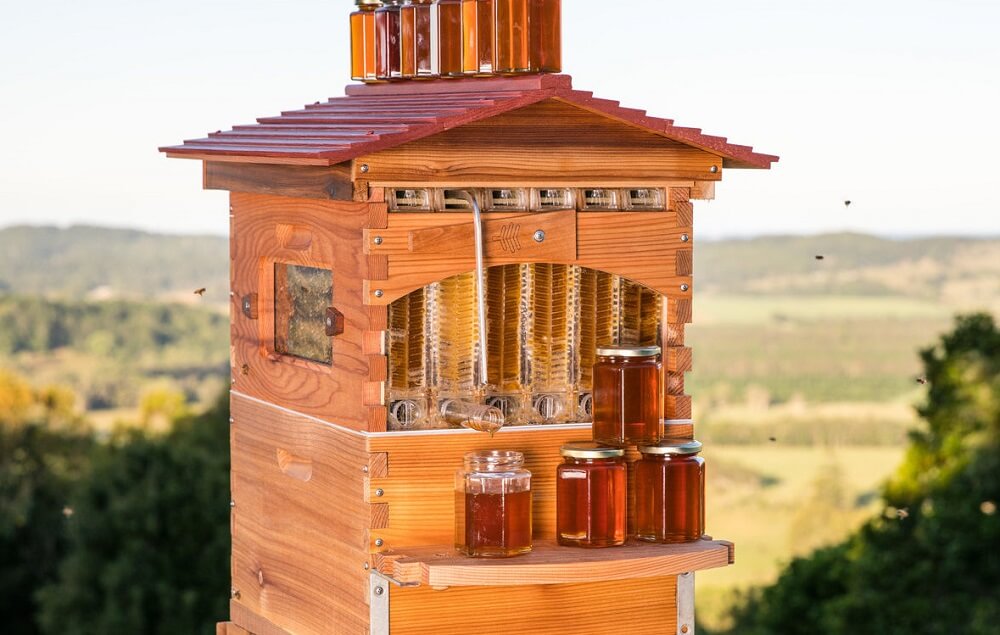
Con 1: Beekeepers in colder climates may struggle with flow hives
I want to be clear.
This isn’t an issue with the flow hive itself. It’s an issue with climate.
Buying a flow hive may not make sense if you have harsh and long winters with little nectar sources available.
But don’t just take it from me.
Below is a fellow beekeeper’s opinion on a flow hive in cold climates. If you live in a place with long and harsh winters, you need to watch this video:
The truth is, flow hives do better in warmer climates. This is why it makes sense that the founders of the flow hive are from Australia.
As a new beekeeper in a cooler climate, I recommend starting with a regular Langstroth hive and getting the hang of beekeeping first. That way, you don’t spend $1,000 on a flow hive only to realize you can’t use it.
Again, it’s not an issue with the flow hive itself. It’s an issue with the climate.
Con 2: Flow hives will cost you a pretty penny
If you’re new to beekeeping, then it might not make sense to spend that much money on a hive.
Why?
Because you may not stick with it. You may try your hand at beekeeping and decide it’s not for you.
It happens.
But don’t get me wrong.
I’m not saying you should skimp on beekeeping equipment and only buy the cheapest stuff. What I am saying, though, is that you should learn about beekeeping before you get started and save money where you can.
The thing about flow hives is that they only make honey harvesting easier for one hive.
If you have other types of hives, then you’ll still need a honey extractor to harvest the honey from those hives. You can get an electric honey extractor for around $400, allowing you to extract honey from an entire apiary.
If you only plan to buy flow hives, this isn’t an issue because you won’t need an extractor.
And at the end of the day, it’s your money, and you can spend it how you like.
Now you might be wondering:
Should I buy a used flow hive?
I don’t recommend it.
Buying used beekeeping equipment is risky business. A used hive may contain infections and diseases that you don’t know about. This puts not only your bees in danger but also surrounding bees in your community.
In fact, some diseases are so contagious that they can take down entire apiaries. American Foulbrood (AFB) is one example.
Diseases like AFB leave behind spores that can survive in beekeeping equipment for decades.
This is why the flow hive company doesn’t allow you to return your hive for a refund if you’ve used it.
And I don’t blame them.
Con 3: The flow frames are plastic
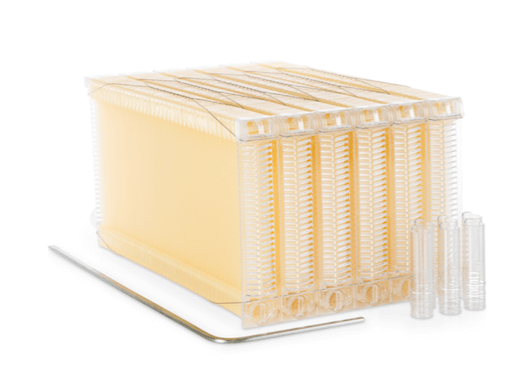
The plastic comb is what allows you to harvest the honey through a tap.
The main downside to this is that it’s nice to allow bees to build their own honeycomb.
Here’s the deal:
Bees will only touch plastic foundations if they’re the only thing left they have to work with. They prefer foundationless, and plastic is the last resort for them.
Because of this, sometimes your bees won’t accept the plastic combs.
But there’s an easy fix for this.
Just brush or rub some beeswax on the face of your flow frames to encourage your bees to take to it.
Also, it’s important to mention:
Flow hives have a single super of plastic combs, and the rest of the hive can be a natural comb or foundation. It’s up to you.
Con 4: You can’t collect beeswax
Beekeepers harvest several products from the beehives. This includes honey and beeswax.
While the flow hive makes collecting honey easier, it prevents you from harvesting wax from your hive because the frames are plastic.
But some beekeepers don’t mind this.
Also, in the flow hive hybrid, you can switch out your flow frames with traditional frames. Of course, this wouldn’t allow you to harvest honey from the tap, but if you want beeswax this is the way to get it.
—> Go back to the flow hive review FAQs
How long do flow hives last?
The key to preserving any wooden hive is to keep water out. As long as you seal all joints and keep your flow hive painted, it can last 10 years or longer.
Depending on your climate, if you don’t maintain or paint your flow hive, it’ll probably start to warp after two or three years.
Maintenance is the key no matter which hive you buy.
Sometimes, you’ll need to scrape it down, repaint, add more screws or nails, and fill in any holes.
And what about the flow frames themselves?
According to the company, flow frames can last over 10 years if used correctly. This means when you remove them from the hive, you should keep them away from sunlight. They recommend storing them in a light-proof container because they’re UV-sensitive.
—> Go back to the flow hive review FAQs
More to Explore:
How do you maintain a flow hive?
For starters, you don’t need to clean the flow frames because the bees will clean them.
The only exception to this is if you detect diseases in the hive. Then you’ll need advice from experienced beekeepers on disease prevention and cleanup.
Besides repainting and filling holes when necessary, here are a few tips and tricks for maintenance from the founders of the flow hive:
—> Go back to the flow hive review FAQs
How do you harvest honey from a flow hive?
There are a few steps to harvesting honey from a flow hive that are easier to show you in a video.
Check it out:
—> Go back to the flow hive review FAQs
How often can you harvest honey from a flow hive?
It depends.
Most beekeepers will harvest one to three times a year between June and September.
Some beekeepers will only harvest once per year if they have a colder climate and fewer nectar sources.
Others will harvest three times a year if they have a warmer climate and plenty of nectar sources available.
If you live in a cold climate with harsh winters, you should think twice about buying a flow hive.
Don’t get me wrong.
It’s not that the flow hive is bad for cold climates. It’s that your climate may be too harsh to warrant that kind of investment.
Take a look at what a fellow beekeeper from Massachusetts has to say about a flow hive in cold climates:
—> Go back to the flow hive review FAQs
What do beekeepers think of flow hives?
As with anything in life, there are varying opinions.
On the one hand, the flow hive remains a popular product amongst beekeepers. It makes harvesting honey a million times easier and cleaner.
If you’ve ever harvested honey with a honey extractor or by hand, then you know how much time and labor can go into it. Most beekeepers have to set aside several days to get the job done.
The flow hive makes this process easier, and that’s why many beekeepers have gravitated toward it.
But there are criticisms of the flow hive as well.
One of the biggest criticisms is that the flow hive promotes “lazy beekeeping.” In other words, buying bees but not doing the proper maintenance and inspections necessary to maintain a healthy hive. Then just assuming you can collect honey without being a proper beekeeper.
Some beekeepers blame this on the marketing videos from the company.
But I disagree.
There are going to be lazy beekeepers no matter what type of hive they buy. It has nothing to do with the flow hive. If someone is lazy, they’re going to be lazy.
Secondly, some beekeepers have issues with the price of the flow hive.
And I can understand this.
The flow hive is a luxury item. It’s not something you’d buy if you’re on a tight budget.
Sure, it makes harvesting honey easier. But there are cheaper ways to get into beekeeping. This is especially true if you’re a new beekeeper who’s just dipping your toes into the hobby. As with any hobby, you have to try it to decide if you really like it.
But what happens if you buy a flow hive and decide beekeeping isn’t for you?
Then you’re out a couple of hundred bucks. This is just for the cost of the flow hive alone. This doesn’t count all the other beekeeping equipment you have to buy like a bee suit, bee smoker, and other hive tools.
So what’s the bottom line?
As with anything, there are going to be pros and cons. Some beekeepers love the flow hive. Some beekeepers hate the flow hive.
Based on our pros and cons list above, you have to decide what’s best for you.
Personally, I like the flow hive. It’s not perfect, but it works well in my climate and is a pretty cool addition to my apiary.
—> Go back to the flow hive review FAQs
How do you put bees in a flow hive? How do you introduce bees to a flow hive?
Great question.
Here’s a video from the flow company demonstrating putting a nuc into a flow hive:
—> Go back to the flow hive review FAQs
Do flow hives harm bees?
No, the flow hive is considered safe for bees – even when you’re harvesting honey. In fact, the flow hive is a less intrusive way to harvest honey.
The myth that flow hives harm bees come from the fact that they’re different from traditional langstroth hives or horizontal hives. But it’s not true.
—> Go back to the flow hive review FAQs
How long does it take for a new hive to produce honey?
Well, let me just say this.
Just because bees are producing honey, that doesn’t mean you should collect it.
As long as flowers are blooming, bees start working to produce honey as fast as they can. This can take just a few short weeks.
But.
You shouldn’t harvest honey from a new hive in the first year. Your new hive needs time to get established, and more importantly, they need enough honey storage to survive the winter.
The bees will eat their honey during the winter to keep them alive. It’s food storage for them.
Beekeepers start harvesting honey from a new hive once they’ve gotten established after the first year.
—> Go back to the flow hive review FAQs
Can you get honeycomb from a flow hive?
No, but there is an exception. Let me explain.
If you’re using flow frames to harvest honey straight from the tap, then you’re not getting any honeycomb from that. The flow frames are made of plastic and the bees fill them with honey. So the bees don’t make honeycomb.
Once you harvest the honey, you’re just getting pure, filtered honey.
The exception to this is if you buy the flow hive hybrid. The hybrid model allows you to put traditional frames in your flow hive so that you can enjoy the honeycomb.
—> Go back to the flow hive review FAQs
How many bees fit in a flow hive?
A healthy colony filling two 10-frame deeps holds around 30,000-60,000 bees.
—> Go back to the flow hive review FAQs
More to Explore:
Where should a flow hive be placed?
Good question.
Here are a few tips:
Tip 1: Pick the right amount of sun
Your hive should be placed where the early morning sun hits. This gets your bees up and going out of their hive.
If you live in a cool climate, you should place your hive in a spot that receives full sun during the day. This helps them stay warmer during the colder months.
If you live in a warm climate, you should place your hive in a spot that gets morning sun and afternoon shade. This keeps the hive cooler during the hot summer months.
Tip 2: No direct wind
Your hive should be in an area with a windbreak. This means fences, trees, shrubbery, or bushes should be close enough to your hive to give it a break from the wind. This is especially important in colder climates where the temperatures drop below freezing.
Tip 3: Consider predators
For example, if you have bears in your area, you might want to check with your local beekeeping agency for tips. Electric fencing may be required to provide extra safety for your hive.
Tip 4: Think about food and water sources
Make sure your bees have access to safe water sources. Bees can’t swim, so they’ll drown if they don’t have landing perches to sit on while they drink. Thankfully, you can turn a birdbath into a safe bee waterer.
Also, planting the best flowers for bees is a smart move. This will go a long way in helping your hive.
You also need to make sugar water for bees when nectar sources aren’t readily available.
—> Go back to the flow hive review FAQs
More to Explore:
Can you stack flow hives?
Yes, you can buy more brood boxes and stack them below the flow super.
Although you could, I wouldn’t stack more than one flow super on a hive. There really isn’t much point because when it’s full, you just turn the key and empty the frames then the bees will start refilling it.
—> Go back to the flow hive review FAQs
More to Explore:
How do you prevent robbing from other colonies in a flow hive?
It’s really simple.
All you need to do is cover your jar where you’re harvesting the honey.
Check out this clip to see what I mean:
—> Go back to the flow hive review FAQs
More to Explore:
What’s the history of the flow hive?
The flow hive was created in Australia by Cedar Anderson and his father Stuart Anderson.
It all began because Cedar felt bad about crushing bees during the honey harvesting process.
They also wanted to create a way to make harvesting honey easier and faster since it can take several days depending on how many hives you have.
“The first idea was simply that there must be a better way, and I’d been thinking about that from a very young age,” says Cedar, who started beekeeping when he was six.
They had been working on several prototypes for years until they finally found one that they liked.
In February 2015, they launched a crowdfunding campaign on Indiegogo. Their goal was to raise $70,000 for their business.
Within minutes of launching on Indiegogo, they had raised over $91,000. By the time the campaign ended, they had nearly 40,000 orders worth over $12 million.
This campaign broke several records for Indiegogo and became its most successful campaign of all time.
Since then, the flow hive has made a name for itself in the beekeeping community.

